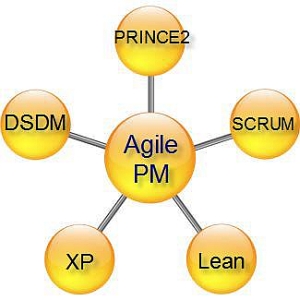The Planning Process – Ten Simple Steps to Planning a Project
 The project planning process is one of the high-level management processes that make the project lifecycle. It is a complex of tasks for setting up a project plan and also defining subsidiary plans. The project planning process is closely linked to the planning phase which is the second phase within the project lifecycle, according to the PMBOK methodology. It comes after the Initiating Process Group (by PMBOK) and the Direct Project (by PRINCE2). For some project managers, planning a project is a real challenge and sometimes they feel confused when trying to define a problem, develop a strategy, build a WBS, establish communications, build teams and so on.
The project planning process is one of the high-level management processes that make the project lifecycle. It is a complex of tasks for setting up a project plan and also defining subsidiary plans. The project planning process is closely linked to the planning phase which is the second phase within the project lifecycle, according to the PMBOK methodology. It comes after the Initiating Process Group (by PMBOK) and the Direct Project (by PRINCE2). For some project managers, planning a project is a real challenge and sometimes they feel confused when trying to define a problem, develop a strategy, build a WBS, establish communications, build teams and so on.
Fortunately, the process for project planning can be simplified in order for managers and planners to better understand how to carry out it in a few simple steps. In this article I won’t talk about the complexity of the project planning process and how it is often hard to set up and plan a new project from scratch. I will focus you on a few simple and important steps for easier and successful planning of projects.
Before we start reviewing the steps for project planning, you must remember that the initiation process precedes the planning process and, hence, you must have a range of project documents that have been designed, agreed and approved upon completion of the initiation process. These documents (also known as the project initiation documents – PIDs) are Project Charter, Business Case, Feasibility Study and Funding Request. The primary document is Project Charter, which is based on the rest documents. You should use PIDs during the planning process.
Step 1. Determine the problem being addressed by your project
The first and foremost step to planning a project refers to defining the actual problem that should be solved upon completion of the project. You must communicate with the customer and use Business Case to describe the problem. The process of project planning also requires you to make a detailed description of the problem. So be ready to set up efficient communications with the customer in order to define and describe the problem.
Step 2. Set up a mission for the project
You should announce a mission of your project that meets the customer’s needs and “strengthens” the major project goals. For successful project planning process, it is important to make a mission statement that outlines the project path and clarifies how the project will be developed. Your mission statement will be a guiding line to your team, so be sure it is designed and set up in accordance with the customer satisfaction principle, and every team member clearly understands the mission.
Step 3. Make a strategic implementation plan
You must develop a project strategy that follows the mission and outlines the high-level actions for implementing the project objectives. At this step to planning a project, you can use Feasibility Study to make sure that the project is really feasible. Then you must strategize the project work and make a detailed implementation plan for the team. Your strategy should show how the project will work, what the team will do, and in what way the project goals will be satisfied.
Step 4. State the scope for your project
This step of the project planning process requires you to make a scope statement that determines project boundaries. A scope statement is a component of the project plan and used as a tool to set up obvious boundaries for project work and also define the extent of the goals. You must use Project Charter to develop a scope statement and plan the project.
Step 5. Create a Work Breakdown Structure
This step is about developing a Work Breakdown Structure (WBS) that identifies the low-level tasks and activities required for doing project work and producing the deliverables. The WBS is a critical piece of the project planning process because it defines how tasks will be structured and what dependencies will be created. It is also used for setting up durations, task assignments, resource requirements, and cost estimates.
Step 6. Schedule project activities
You must develop a project schedule that shows durations for individual tasks and processes listed in the WBS. You must calculate the overall project duration and include it in the schedule. This step to project planning also requires you to make resource assignments and define who will do what tasks within which period of time.
Step 7. Make a budget sheet
Once the tasks have been set up, assigned to team members and scheduled it is time to estimate costs necessary for the implementation. You should use cost estimates to develop a budget sheet for your project. This document of the project planning process should be discussed with the Sales team and communicated to the customer and sponsor. In addition, Funding Request serves as a foundation for setting up the budget.
Step 8. Develop the project organization structure
This step to planning a project is critical as it determines what and how specific job responsibilities and authorities will be involved in the implementation. The project organization structure is a framework of policies and procedures for the project based on the PIDs and designed to set up all the duties, responsibilities and roles for the team in order to ensure the successful implementation process, achieve the project goals, and produce the deliverables. You can use the PIDs to define the team’s functional operations and procedures.
Step 9. Set up tools for team communication and collaboration
Team collaboration is always critical to project success. If team members are enabled to efficiently communicate with each other, make joint efforts and exchange project data, they get more chances for successfully implementing the WBS tasks and producing the deliverables. That’s why you should provide tools (like templates, software solutions, communication plan and policy, reporting requirements) for setting up efficient communication channels and creating a collaborative working environment.
Step 10. Develop the general plan for your project
The final step to planning of your project is about developing the general plan that includes all the tools, solutions and decisions identified at the previous 9 steps. The project management plan is the output of the project planning process. It is a documented sequence of actions for executing and controlling the project and its activities. The general plan includes a range of subsidiary plans that define how to manage identified risks, exploit opportunities, respond to changes, schedule time, set up communications etc. You should make the plan in strict accordance with the mission statement and the major goals of your project.
All the steps to planning a project are listed. I hope this information will help you with planning your new projects and programmes. I suggest you use some task management software to create a checklist with the listed steps of the project planning process. Then, each time when you begin a new project you can open your checklist and follow the guidelines. Actually I always carry out the project planning process with help of my checklists and task management software.














